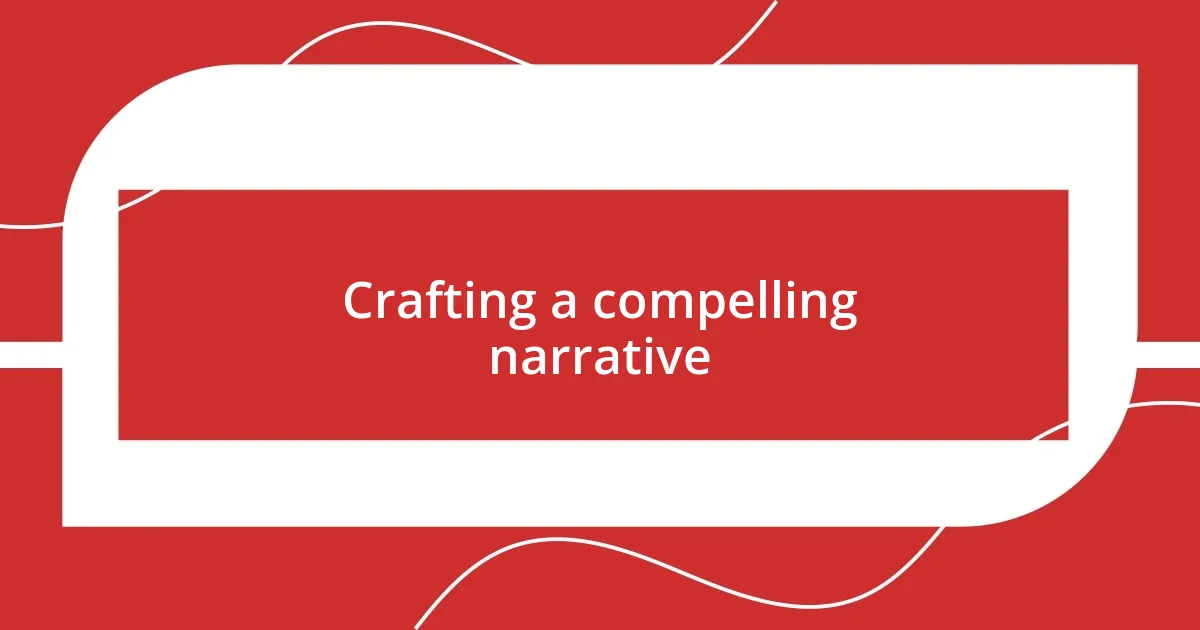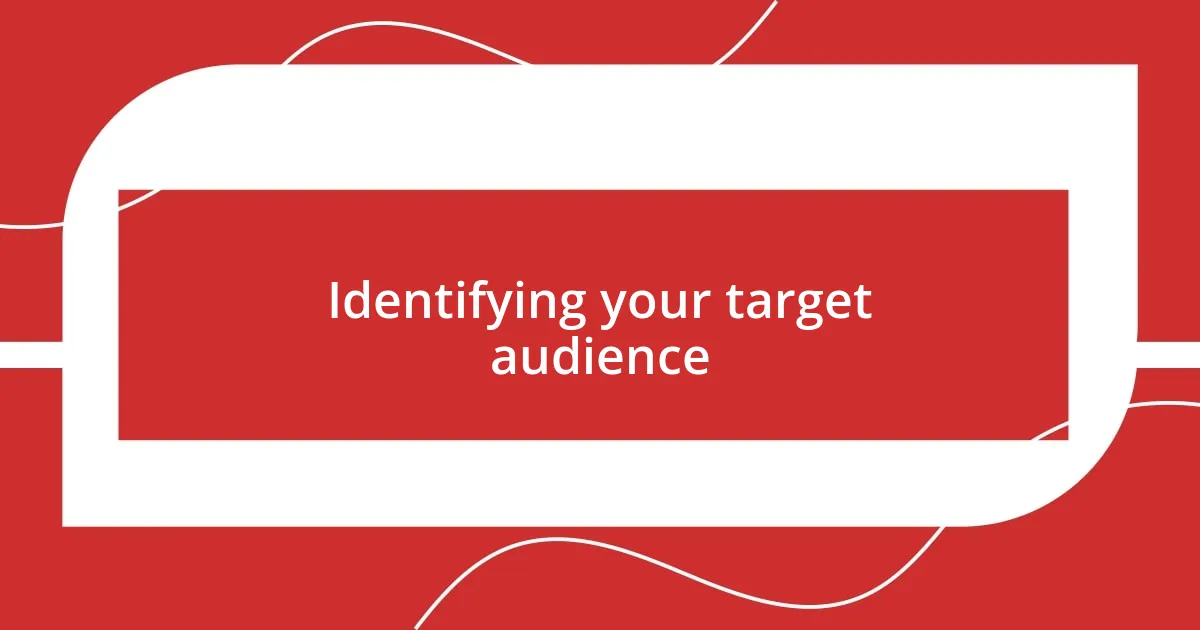Key takeaways:
- Storytelling creates emotional connections and fosters empathy through shared human experiences.
- Crafting narratives involves authenticity, audience awareness, and vivid imagery to engage effectively.
- Identifying target audiences enhances relatability and trust, making stories resonate more deeply.
- Incorporating visuals and strong openings can significantly improve audience engagement and retention of the message.

Understanding the power of storytelling
Storytelling has a unique ability to connect with people on a deep emotional level. I remember a time when I shared a story about overcoming failure during a presentation, and I could see the nods of recognition from the audience. It made me realize that when we share our vulnerabilities, we foster true connection and understanding, which can be incredibly powerful.
Have you ever found yourself completely absorbed in a story, feeling as if you were living those moments? I once listened to a colleague narrate their journey through a tough period in their life, and it struck a chord. That moment made me understand that stories aren’t just entertainment; they are windows into our shared human experience, guiding us through emotions we might otherwise struggle to articulate.
The power of storytelling lies not just in what is said, but how it resonates. During a community event, I shared a personal tale about my first job’s challenges. The audience responded with their own related experiences, creating a rich tapestry of connections. Isn’t it fascinating how a simple narrative can ignite conversations, illustrate a point, or unite groups? It reminds me that at the heart of storytelling is the ability to spark empathy and inspire action.

Crafting a compelling narrative
Crafting a compelling narrative requires a blend of authenticity and structure. I recall writing a story about a pivotal moment in my career. It was challenging, yet sharing my true self allowed others to relate on a level I hadn’t anticipated. People often connect through shared experiences, and that personal touch transforms a narrative from mere words on a page into a heartfelt dialogue.
An essential element is knowing your audience. One time, I tailored a story about a mentor who inspired me during difficult times, adjusting my language and examples to resonate with a younger crowd. Watching their eyes light up as they recognized their struggles in my story was incredibly rewarding. It’s curious how adjusting our narratives to fit our audience not only enhances engagement but also opens up a space for empathy and understanding.
Crafting a compelling narrative also involves using imagery that evokes emotions. I once employed rich descriptions when recounting a summer abroad. I painted pictures of sunsets and sounds of laughter that transported listeners directly into my experiences. Isn’t it amazing how vivid imagery enhances storytelling? It makes the narrative more immersive, allowing the audience to experience the journey alongside you.
| Element | Description |
|---|---|
| Authenticity | Sharing personal truths to forge connections. |
| Audience Awareness | Adapting stories to resonate with specific groups. |
| Imagery | Using descriptive language to evoke emotions. |

Identifying your target audience
Understanding your target audience is crucial for effective storytelling. I learned this firsthand during a workshop where I needed to present to a diverse group of professionals. Instead of sticking to my usual narrative, I spent time researching their backgrounds and interests, which led me to tailor my story about leadership challenges. The response was eye-opening; the more I aligned my content with their experiences, the more engaged they became. It was like watching a light switch flick on when they connected with the story.
To effectively identify your target audience, consider the following:
-
Demographics: Understand the age, gender, and background of your audience. I once adjusted a story about my childhood experiences for a mixed group, ensuring the language and themes were relevant to both younger and older listeners.
-
Interests and values: Dig into what matters to your audience. During a charity event, I learned that many attendees were passionate about sustainability, so I shifted my narrative to incorporate themes of environmental stewardship.
-
Goals and challenges: Knowing what your audience wants to achieve can shape your storytelling. For example, when sharing a success story with entrepreneurs, I highlighted obstacles I faced and overcome, which resonated deeply with their journeys.
Connecting on these levels not only enhances storytelling but also builds a foundation of trust and relatability with your audience.

Incorporating emotional connections
Incorporating emotional connections is at the heart of impactful storytelling. I remember a time when I shared a heartfelt story about my grandmother, who persevered through hardships. As I spoke about her sacrifices, I could see tears welling in the eyes of my audience. Isn’t it fascinating how a simple personal story can evoke such deep emotions and create a shared space of empathy?
One technique I found effective is weaving vulnerability into my narratives. When I admitted my own struggles with self-doubt during a presentation, the room shifted in dynamic. Suddenly, people were nodding in agreement, connecting their own experiences to mine. Have you ever noticed how revealing our vulnerabilities can make us more relatable? It’s almost like we lift a weight off others’ shoulders, inviting them to share their stories, too.
Moreover, I often use questions to draw my audience in emotionally. For instance, when I discuss a challenging time in my life, I might ask, “Have you ever felt completely lost?” This rhetorical question encourages individuals to reflect on their journeys, forming a bond based on shared human experience. Through these emotional connections, storytelling transforms into a powerful vehicle for understanding and growth.

Using visuals to enhance stories
Visuals play a transformative role in storytelling, and I’ve seen their impact firsthand. During a presentation on team dynamics, I used a vibrant infographic depicting the stages of team development. The audience’s engagement skyrocketed as they could visualize the concepts I was discussing. Have you ever noticed how a well-placed image can capture attention in ways words alone sometimes fail to? It’s like providing a map for your listeners to follow along, making the journey more relatable.
When I’ve integrated videos into my presentations, the reaction was overwhelmingly positive. For instance, once, I shared a short clip of a community coming together after a crisis. The visuals not only illustrated the story but also stirred emotions, prompting discussions afterward. It’s incredible to see how a moving image can bridge gaps between people’s experiences and what you’re trying to convey. Don’t underestimate the power of a visual moment—it can cement your message in the audience’s memory even more firmly than the words you choose.
Lastly, I’ve experimented with simple visuals, like bullet-point slides that highlight key takeaways. This technique often serves as a guidepost, ensuring my audience stays on track with me. I remember during one workshop, as I transitioned from one point to another with clear visuals, I could almost see the collective nodding of heads—an unspoken agreement that they were following along. Visuals can enhance clarity by breaking down complex ideas into digestible pieces, making it easier for everyone to connect with the central narrative. Wouldn’t you agree that effective visuals enhance understanding, making stories not just heard but felt?

Practical tips for effective storytelling
One of my favorite tips for effective storytelling is to embrace the power of a strong opening. I recall a time when I started a talk with a bold, unexpected statement: “What if I told you that failure can be the best teacher you’ll ever have?” The room fell silent, and I could feel curiosity building. It’s a great way to immediately catch attention and set the stage for the emotions and lessons that follow. Have you ever thought about how a gripping introduction can change the entire tone of your story?
Another practical approach is to create a vivid setting. While sharing a story about my childhood adventures in a small fishing village, I painted a picture of the salty air and bustling docks. By describing the sensory details, I transported my audience into that moment with me. Isn’t it remarkable how specific imagery can evoke feelings and transport listeners to a different time and place? They weren’t just hearing my story; they were experiencing it along with me.
Lastly, I always remember the importance of a clear takeaway. During a recent workshop, after sharing a particularly challenging experience, I wrapped up by asking the audience to reflect on what they could learn from it. “What lessons can we carry forward together?” This call to action not only reinforces the story’s message but also invites participants to engage actively with it. Sharing stories can inspire reflection, but providing a clear takeaway ensures that the impact lingers long after the story ends. Don’t you think that clarity in messaging can transform storytelling from a passive experience to an empowering one?















